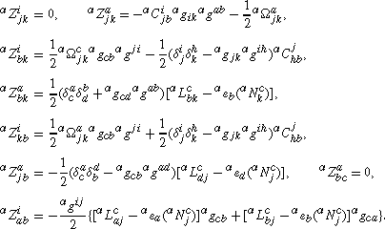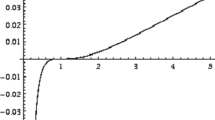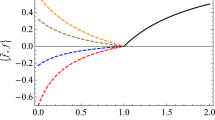Abstract
We study the fractional gravity for spacetimes with non-integer fractional derivatives. Our constructions are based on a formalism with the fractional Caputo derivative and integral calculus adapted to nonholonomic distributions. This allows us to define a fractional spacetime geometry with fundamental geometric/physical objects and a generalized tensor calculus all being similar to respective integer dimension constructions. Such models of fractional gravity mimic the Einstein gravity theory and various Lagrange–Finsler and Hamilton–Cartan generalizations in nonholonomic variables. The approach suggests a number of new implications for gravity and matter field theories with singular, stochastic, kinetic, fractal, memory etc processes. We prove that the fractional gravitational field equations can be integrated in very general forms following the anholonomic deformation method for constructing exact solutions. Finally, we study some examples of fractional black hole solutions, ellipsoid gravitational configurations and imbedding of such objects in solitonic backgrounds.
Similar content being viewed by others
Notes
In “integer” differential geometry, there are used also equivalent terms like anholonomic and non-integrable manifolds. A nonholonomic manifold of integer dimension is defined by a pair \((\mathbf{V},\mathcal{N})\), where V is a manifold and \(\mathcal{N}\) is a nonintegrable distribution on V, see the next section for a generalization to non-integer dimensions.
The left Riemann–Liouville (RL) derivative is
$${}_{_{1}x}\overset{\alpha}{\partial}_{x}f(x):=\frac{1}{\Gamma (s-\alpha)}\biggl( \frac{\partial}{\partial x}\biggr) ^{s}\int_{_{1}x}^{x}(x-x^{\prime})^{s-\alpha-1}f(x^{\prime})\,dx^{\prime},$$where Γ is the Euler’s gamma function. The left fractional Liouville derivative of order α, where s−1<α<s, with respect to coordinate x is \(\overset{\alpha }{\partial }_{x}f(x):=\lim_{_{1}x\rightarrow -\infty }{}_{\ _{1}x}\overset{\alpha }{\partial }_{x}f(x)\).
The right RL derivative is \({}_{x}\overset{\alpha }{\partial }_{_{2}x}f(x):=\frac{1}{\Gamma (s-\alpha )}( -\frac{\partial }{\partial x}) ^{s}\int_{x}^{_{2}x}(x^{\prime }-x)^{s-\alpha -1}f(x^{\prime })\,dx^{\prime }\). The right fractional Liouville derivative is \({}_{x}\overset{\alpha }{\partial }f(x^{k}):=\lim_{_{2}x\rightarrow \infty }{}_{\ x}\overset{\alpha }{\partial }_{_{2}x}f(x)\).
The fractional RL derivative of a constant C is not zero but, for instance, \({}_{_{1}x}\overset{\alpha}{\partial}_{x}C=C\frac{(x-_{1}x)^{-\alpha}}{\Gamma(1-\alpha)}\). Integro-differential constructions based only on such derivatives seem to be very cumbersome and has a number of properties which are very different from similar ones for the integer calculus.
This follows from the fundamental theorem of fractional calculus [35]
For the “integer” calculus, we use as local coordinate co-bases/-frames the differentials dx j=(dx j)α=1. For 0<α<1 we have dx=(dx)1−α(dx)α. The “fractional” symbol (dx j)α, related to \(\overset{\alpha}{d}x^{j}\), is used instead of dx i for elaborating a co-vector/differential form calculus, see below the formula (6).
The N-adapted coefficients are explicitly determined by the (13),

We can verify that introducing above formulas into (15) we obtain that \(\widehat{T}_{\ jk}^{i}=0\) and \(\widehat{T}_{\ bc}^{a}=0\), but \(\widehat{T}_{\ ja}^{i},\widehat{T}_{\ ji}^{a}\) and \(\widehat{T}_{\ bi}^{a}\) are not zero, and that the metricity conditions are satisfied in component form.
The N-adapted coefficients of distortion tensor \(Z_{\ \alpha\beta }^{\gamma}\) are computed

Such transforms of geometric objects (with deformations of the frame, metric, connections and other fundamental geometric structures) are more general than those considered for the Cartan’s moving frame method, when the geometric objects are re-defined equivalently with respect to necessary systems of reference.
ε is an eccentricity because, for integer configurations, the coefficient \(h_{4}=b^{2}=\eta_{4}(\xi,\vartheta ,\varphi,\bar{\theta})\varpi^{2}(\xi)\) becomes zero for data (53) if \(r_{+}\simeq{2\mu_{0}}/[{1+\varepsilon\frac {q_{0}(r)}{4\mu ^{2}}\sin(\omega_{0}\varphi+\varphi_{0})}]\); this is the “parametric” equation for an ellipse r +(φ) for any fixed values \(\frac{q_{0}(r)}{4\mu^{2}},\omega_{0},\varphi_{0}\) and μ 0.
A function η can be a solution of any three dimensional solitonic and/or other nonlinear wave equations
References
Albu, I.D., Neamţu, M., Opriş, D.: The geometry of fractional osculator bundle of higher order and applications. arXiv:0709.2000
Baleanu, D.: Fractional Hamilton formalism with Caputo’s derivative. arXiv:math-ph/0612025
Baleanu, D., Muslih, S.: Phys. Scr. 72, 119 (2005)
Baleanu, D., Trujillo, J.J.: Nonlinear Dyn. 52, 331 (2008)
Baleanu, D., Vacaru, S.: J. Math. Phys. 52, 053514 (2011)
Baleanu, D., Vacaru, S.: Nonlinear Dyn. 64, 365 (2011)
Baleanu, D., Vacaru, S.: Int. J. Theor. Phys. 50, 233 (2011)
Boleantu, M., Opris, D.: Fractional dynamical systems and applications in mechanics and economics. arXiv:0709.1681 [math.DS]
Carreras, B.A., Lynch, V.E., Zaslavsky, G.M.: Phys. Plasmas 8, 5096 (2001)
Carpinteri, A., Mainardi, F.: Fractals and Fractional Calculus in Continuous Mechanics. Springer, New York (1997)
Herrmann, R.: Gauge invariance in fractional field theories. arXiv:0708.2262
Hilfer, R. (ed.): Applications of Fractional Calculus in Physics. World Scientific, Singapore (2000)
Kilbas, A.A., Srivastava, H.M., Trujillo, J.J.: Theory and Application of Fractional Differential Equations. Elsevier, Amsterdam (2006)
Laskin, N.: Phys. Lett. A 268, 298 (2000)
Laskin, N.: Phys. Rev. E 66, 056108 (2002)
Li, M.-F., Ren, J.-R., Zhu, T.: Series expansion in fractional calculus and fractional differential equations. arXiv:0910.4819
Munkhammar, J.: Riemann–Liouville fractional Einstein field equations. arXiv:1003.4981
Muslih, S.: A formulation of Noether’s theorem for fractional classical fields. arXiv:1003.0653
Muslich, S., Agrawal, O., Baleanu, D.: J. Phys. A, Math. Theor. 43, 055203 (2010)
Naber, M.: J. Math. Phys. 45, 3339 (2004)
El-Naulsi, A.: Chaos, Solitons and. Fractals 42, 2924 (2009)
El-Nabulsi, A.: Rom. Rep. Phys. 59, 763 (2007)
Nishimoto, K.: Fractional Calculus: Integrations and Differentiations of Arbitrary Order. University of New Haven Press, New Haven (1989)
Oldham, K.B., Spanier, J.: The Fractional Calculus: Theory and Applications of Differentiation and Integration to Arbitrary Order. Academic Press, San Diego (1974)
Podlubny, I.: Fractional Differential Equations. Academic Press, San Diego (1999)
Raspini, A.: Phys. Scr. 64, 202 (2001)
Riewe, F.: Phys. Rev. E 55, 3581 (1997)
Ren, F.-Y., Qiu, W.-Y., Liang, J.-R., Wang, X.-T.: Phys. Lett. A 288, 79 (2001)
Roberts, M.D.: Fractional derivative cosmology. arXiv:0909.1171
Ross, B.: Lect. Notes Math. 457, 1 (1975)
Tarasov, V.E.: Chaos 15, 023102 (2005)
Tarasov, V.E.: Phys. Plasmas 13, 052107 (2006)
Tarasov, V.E.: Celest. Mech. Dyn. Astron. 19, 1 (2006)
Tarasov, V.E.: J. Phys. A 39, 8409 (2006)
Tarasov, V.E.: Ann. Phys. 323, 2756 (2008)
Tarasov, V.E., Zaslavsky, G.M.: Physica A 368, 399 (2006)
Vacaru, S.: J. Math. Phys. 37, 508 (1996)
Vacaru, S.: Ann. Phys. 256, 39 (1997)
Vacaru, S.: Ann. Phys. 290, 83 (2001)
Vacaru, S.: Int. J. Mod. Phys. D 12, 461 (2003)
Vacaru, S.: J. Math. Phys. 46, 042503 (2005)
Vacaru, S.: J. Math. Phys. 47, 093504 (2006)
Vacaru, S.: J. Math. Phys. 48, 123509 (2007)
Vacaru, S.: Phys. Lett. A 372, 2949 (2008)
Vacaru, S.: Int. J. Geom. Methods. Mod. Phys. 5, 473 (2008)
Vacaru, S.: J. Math. Phys. 49, 043504 (2008)
Vacaru, S.: Int. J. Geom. Methods. Mod. Phys. 6, 873 (2009)
Vacaru, S.: J. Math. Phys. 50, 073503 (2009)
Vacaru, S.: Acta Appl. Math. 110, 73 (2010)
Vacaru, S.: Int. J. Theor. Phys. 49, 884 (2010)
Vacaru, S.: Class. Quantum Gravity 27, 105003 (2010)
Vacaru, S.: Fractional Nonholonomic Ricci Flows. arXiv:1004.0628
Vacaru, S., Dehnen, H.: Gen. Relativ. Gravit. 35, 209 (2003)
Vacaru, S., Popa, F.C.: Class. Quantum Gravity 18, 4921 (2001)
Vacaru, S., Singleton, D.: Class. Quantum Gravity 19, 3583 (2002)
Vacaru, S., Tintareanu-Mircea, O.: Nucl. Phys. B 626, 239 (2002)
Zaslavsky, G.M.: Hamiltonian Chaos and Fractional Dynamics. Oxford University Press, Oxford (2005)
Zaslavsky, G.M., Edelman, M.A.: Physica D 193, 128 (2004)
Zavada, P.: J. Appl. Math. 2, 163 (2002)
Author information
Authors and Affiliations
Corresponding author
Rights and permissions
About this article
Cite this article
Vacaru, S.I. Fractional Dynamics from Einstein Gravity, General Solutions, and Black Holes. Int J Theor Phys 51, 1338–1359 (2012). https://doi.org/10.1007/s10773-011-1010-9
Received:
Accepted:
Published:
Issue Date:
DOI: https://doi.org/10.1007/s10773-011-1010-9






